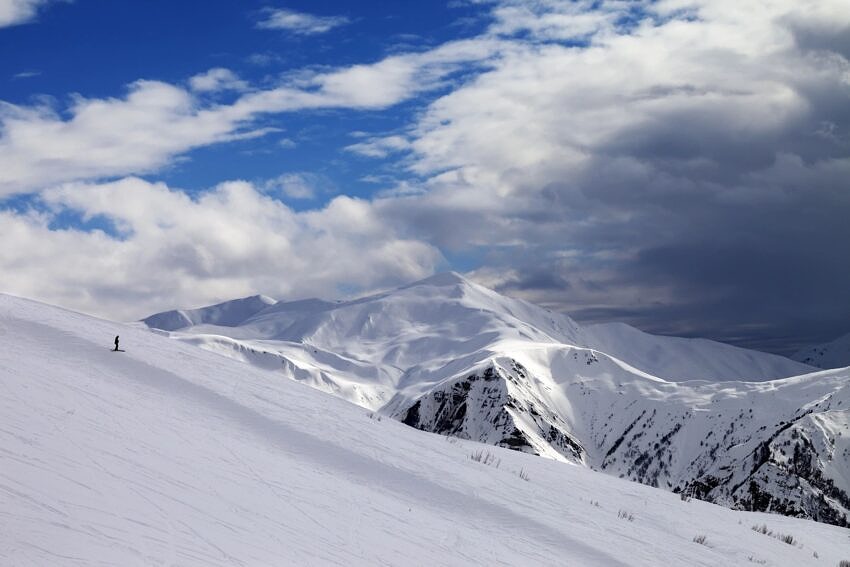For the past two or three ski seasons, I have been venturing more and more in the backcountry searching for those epic powder lines that many skiers dream of, but venturing is not without a higher level of risk. I have found that venturing into the backcountry isn’t the same as visiting the local climbing crag or riding the local singletrack where everything is within cell service. Backcountry skiing is, well, just that…backcountry, and even though it’s easy to romanticize the solitude, the access to big peaks and finding those hidden gems of stashed pow, it’s easy to forget the dangers. One of the biggest dangers is exposure to avalanche terrain and rather than venturing out fool-heartedly, it’s worth getting the training on how to travel in avalanche terrain with an AIARE Avy 1 course and an Avalanche Rescue Course. I recently did both of the courses, and I learned just how little I knew, and how much more learning is needed.
Beacon, Shovel, Probe – The Holy Trinity of Avalanche Rescue



When getting into backcountry skiing, the first thing that anyone typically advises is to get an avalanche beacon, a shovel and a probe, but one thing is getting these things and stuffing them neatly into your day pack, and it’s a different thing on how to use them in the event of an avalanche that results in a burial. Using these items requires following a step-by-step process that my experience has shown to do three things, 1) limit additional risk and exposure to any additional dangers that may affect those of the team still above ground, 2) develop a clear plan to begin a systematic search and rescue, and 3) treat the patient, because once you dig the buried skier out from the rubble, chances are they’ve experienced some trauma, and now you have a patient on your hands. Even within the three broad strokes of activities that goes into an avalanche rescue, there lies a multitude of step-by-step processes that are used to increase the chances of a successful rescue, to which I would strongly recommend taking the course and getting the training. Just having the tools isn’t enough. Having the tools and knowledge how to use them properly is what saves lives.
My biggest take-aways from the Avalanche Rescue Course are A) practice, practice, practice using the gear and following the processes so that in the event an avalanche occurs resulting in a burial, there’s been enough training that following the steps is just muscle memory and one can execute the steps dispassionately and with focus. B) This one is a biggie which is to be more “choosy” on who you go with into the backcountry. Have they had any avalanche rescue experience? Do they know what to do in the event their partner gets buried? This was quite the epiphany for me because it’s typically not a conversation that readily comes up, but should be a big topic of conversation. At the risk of sounding like an arrogant prick, don’t be afraid to have that conversation. You can be the one that ends up buried.
AVY 1 – It’s Not Just About Digging a Pit
One thing I’ve noticed about learning the ins and outs of avalanche risk is the amount of emphasis that’s placed on snow science. There’s so much emphasis on digging snow pits, studying the layers, and looking for weaknesses, that for the untrained can be a little misleading. It is possible that digging a snow pit and testing the layers can give you misleading results which can lead to getting buried, because the snowpack can give you one result, and then fifty feet to your left can give you a different result, yet all over YouTube are videos upon videos about digging pits and testing the snowpack. Although digging a pit is an essential piece to the avalanche puzzle, it’s not the only piece. Pieces like forecasts, weather and having a fundamental understanding of what causes avalanches are just as important, if not more, to traveling in the backcountry.
Like most things in life, having a fundamental understanding is key to learning how things work. Have you ever asked yourself, “How does a toilet work?”. The answer is simple if you think fundamentally….it works by gravity. Fundamental understanding of avalanches is the biggest tool in your toolbox to traveling in the backcountry, and much of this fundamental understanding can be learned through internet resources, but the Avy 1 Course provides a practical application of these fundamental principles by experienced professionals, which is key, because it’s one thing to learn these things on-line and it’s a different thing putting them into practice in the field.
One of the biggest eye-opening fundamentals for me wasn’t fundamental understandings of how avalanches work, but fundamentals of human behavior and team dynamics. Terms like “cognitive dissonance” and “leader halo” were not terms I was expecting to hear in an avalanche training course, but boy does it make sense. Your ego can be your worst enemy, and as the instructor put it, “Your ego is not your amigo.”. Having clear communication among a team of backcountry skiers and giving everyone the opportunity to voice their thoughts and granting everyone on the team veto power is a big skill to learn.
There are a lot of great lines to be skied in the backcountry, but those lines are not always going to be safe to ride. Not to worry, there’s plenty of safe pow turns to be had out there, but to find those turns requires the training provided by an Avy 1 and Avalanche Rescue Course. So, get the gear and get the training to identify red flags, identify terrain, travel safely, and perform of rescue if that were to happen, and practice, practice, practice.

